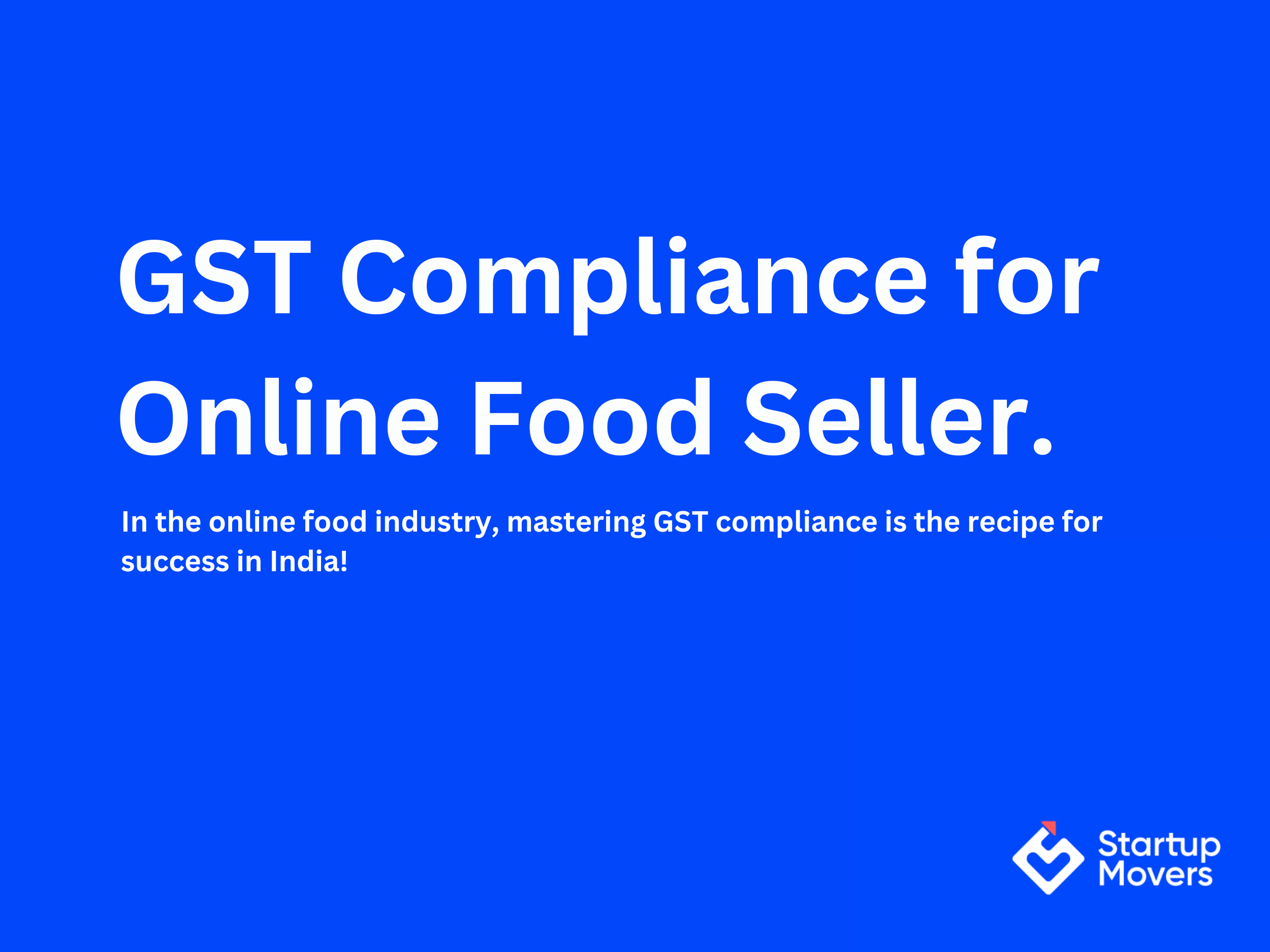Understanding Softex Filings




Managing GST Compliance for Online Food Sellers can be challenging, with high tax rates and tricky TCS rules. Avoid penalties with our guide that simplifies compliance, ensuring smooth business operations. Scroll down to learn more!
The online food delivery market has seen explosive growth, projected to reach ₹1.2 trillion (approximately $16 billion) by 2024 in India alone with a CAGR of 20% from 2021 to 2026. With platforms like Swiggy and Zomato driving this demand, the landscape for food sellers has evolved significantly.
This rapid expansion has made GST compliance increasingly critical for online food sellers, including delivery services, takeout options, cloud kitchens, e-reservations and e-payments..
|
Feature |
Delivery Services |
Takeout Options |
Cloud Kitchens |
|
Order Method |
Online/app, delivered to customer |
In-person/phone, customer pickup |
Online/app, delivery-only |
|
Customer Reach |
Based on delivery radius |
Local customers only |
Broader delivery area |
|
Setup |
Traditional restaurant kitchens |
Restaurant kitchens, dine-in also possible |
Delivery-only kitchens |
|
Cost |
Delivery fees |
Moderate, no delivery cost |
Lower overhead, no dine-in |
|
Advantage |
Convenient home delivery |
Quick pickup, no delivery wait |
Efficient, wide delivery reach |
|
Limitation |
Potential delivery delays |
Limited reach, requires pickup |
No customer interaction or brand presence |
Moreover, around 80% of food delivery businesses report challenges related to GST compliance, which can lead to significant financial repercussions.
Recent updates to GST laws have added layers of complexity, making it essential for sellers to stay informed. Ensuring compliance not only helps avoid legal troubles but also enhances business credibility and consumer trust.
Understand the importance of GST compliance - Explore the benefits and essentials to elevate your business
Dive in todayThe GST Council, recognizing the unique challenges in the digital food service sector, revised the GST framework under section 9(5) of the CGST Act during their 45th meeting.
As per these revisions, the responsibility of paying GST for restaurant services delivered through e-commerce platforms now falls on the operators themselves, effective from January 1, 2022. This significant move simplifies the tax burden on small food service providers and ensures a more centralized collection point for GST.
Compliance Requirements for E-Commerce OperatorsE-commerce platforms are no longer required to collect Tax Collected at Source (TCS) or file GSTR-8 concerning restaurant services for which they pay GST. This change reduces the administrative burden and compliance complexity previously placed on these platforms. However, it's crucial to note that for goods and services not covered under section 9(5), ECOs must continue to manage TCS and adhere to the existing GST compliance mechanisms. |
Under the GST law in India, online food sellers, including those operating through platforms like Swiggy and Zomato, are required to register for GST if they meet certain criteria.
But starting January 1, 2022, these platforms took over the responsibility of handling GST. This change means these sellers don't need to register separately. However, if a restaurant's total sales, both online and offline, cross the GST threshold, they must register for GST.
While GST registration is generally not mandatory for food sellers operating on e-commerce platforms, there are specific exemptions and schemes available for offline businesses:
Understanding GST rates is crucial for online food sellers, as different types of food items and services carry distinct tax rates. Here’s a simplified breakdown:
|
S No |
Type of Restaurants |
GST Rate |
|
1 |
Food supplied or catering services by Indian Railways/IRCTC |
5% without ITC |
|
2 |
Standalone restaurants, including takeaway |
5% without ITC |
|
3 |
Standalone outdoor catering services or food delivery service |
5% without ITC |
|
4 |
Restaurants within hotels (Where room tariff is less than Rs 7,500) |
5% without ITC |
|
5 |
Normal/composite outdoor catering within hotels (Where room tariff is less than Rs 7,500) |
5% without ITC |
|
6 |
Restaurants within hotels (Where room tariff is more than or equal to Rs 7,500) |
18% with ITC |
|
7 |
Normal/composite outdoor catering within hotels (Where room tariff is more than or equal to Rs 7,500) |
18% with ITC |
|
In response to industry feedback and concerns about the high GST rate, the Finance Ministry is reportedly considering a proposal to reduce the GST on online food delivery fees from 18% to 5%. This potential change is aimed at simplifying the tax structure and making online food delivery services more affordable for consumers. The move is expected to not only benefit customers but also enhance compliance and increase the tax base by making the pricing more transparent and manageable for service providers. |
By knowing these rates, online food sellers can ensure they’re charging customers the right GST amount and maintaining compliance, especially when offering varied services like dine-in, takeaway, and delivery.
Recent GST Demand on Zomato: A Case Study on ComplianceThe Indian GST department has recently levied a substantial demand on Zomato, one of the leading food delivery platforms, amounting to approximately Rs. 800 crore. This demand consists of Rs. 401.7 crore in unpaid taxes, with an additional equivalent amount in fines, summing up to more than four times Zomato's profit for the July-September 2024 quarter.
|
Online food sellers, including those operating through e-commerce platforms, must diligently manage their GST filings to stay compliant and avoid penalties.
Key forms include GSTR-1, GSTR-3B, and GSTR-9, each with specific deadlines:
Regarding the specific handling of transactions by e-commerce operators (ECOs), it's important to note that they cannot report restaurant supplies as inward supplies in their GSTR-3B filings.
Since ECOs are facilitators, not the final recipients of these services, they must not include these transactions as inward supplies, which could otherwise suggest they are consuming the services themselves.
This distinction helps maintain clarity in tax reporting and ensures that the GST collected is correctly attributed and remitted by the responsible party, avoiding misreporting and potential compliance issues.
In the new GST landscape, e-commerce operators like Swiggy and Zomato are now responsible for issuing invoices and collecting GST directly from consumers. This shift, effective for services under section 9(5) of the GST Act, streamlines processes by shifting tax duties from restaurants to platforms.
Restaurants must update their e-invoicing systems to integrate smoothly with these changes, ensuring compliance and enhancing operational efficiency.
This streamlined approach allows restaurants to focus more on culinary quality and customer service, while the platforms handle the complexities of GST compliance.
To wrap up, understanding and adhering to GST regulations is essential for online food businesses to ensure smooth operations and avoid costly errors. Consistent compliance, proactive record-keeping, and leveraging technology can lead to greater efficiency.
Let us support you - Discover expert strategies and solutions to effectively manage your compliance issues!
Get on a 1:1 call with us1. Do e-commerce operators (ECOs) need a separate GST registration to handle restaurant services?
Answer: No, e-commerce operators who are already registered under GST do not need a separate registration to manage taxes for restaurant services provided through their platforms.
Since they are already registered under the general provisions of the CGST Rules, 2017, this existing registration covers the payment of tax on restaurant services as outlined in section 9(5) of the CGST Act. This means they can use their current GST registration to comply with tax requirements without additional registrations.
2. Are e-commerce operators (ECOs) responsible for paying GST on restaurant services provided by unregistered businesses?
Answer: Yes, e-commerce operators are required to pay GST on all restaurant services that they facilitate, even if those services are provided by unregistered businesses.
This responsibility ensures that all restaurant services sold through these platforms are compliant with GST regulations, regardless of the registration status of the actual service provider.
3. Are e-commerce operators (ECOs) required to reverse their Input Tax Credit (ITC) due to GST payments on restaurant services?
Answer: No, e-commerce operators do not need to reverse their Input Tax Credit (ITC) when they pay GST on restaurant services. ECOs, who act as intermediaries providing a platform for restaurants and customers, typically use ITC to offset GST liabilities for the services they provide directly, such as commission or fees.
This ability to claim ITC remains unchanged even though they are responsible for the GST on restaurant services provided through their platform. It's important to note that while ECOs can use ITC for other services, the GST payable on restaurant services must be settled in cash and cannot be offset using ITC.

